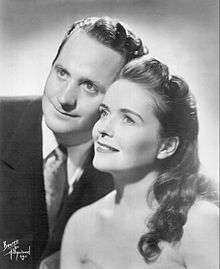Les Paul and Mary Ford

Les Paul and Mary Ford were a popular 1950s husband-and-wife guitar duo in which Les Paul played lead guitar and Mary Ford sang. In 1951 alone, they sold six million records.
Background
The couple were introduced to each other by Gene Autry in 1946 and were married on December 31, 1949.[1]
They first appeared in the pop charts in 1950. Between the years 1950 and 1954, Les Paul and Mary Ford had 16 top-ten hits. They had five top-ten hits within nine months. "Tennessee Waltz", "Mockin' Bird Hill", "How High the Moon" (#1 for nine weeks), "The World Is Waiting for the Sunrise" and "Whispering". From August 1952 to March 1953 they had five more top-ten hits; "My Baby's Coming Home", "Lady of Spain", "Bye Bye Blues", "I'm Sitting on Top of the World" and "Vaya Con Dios" (#1 for 11 weeks). Their 1954 version of "I'm a Fool to Care" went to #6, and was featured in a memorable Southern Comfort commercial in 2013 that got over 1 million views on YouTube.[2]
In 2009, they were inducted into the Hit Parade Hall of Fame.[3]
Paul and Ford are famous for creating a makeshift recording studio in their garage. In their garage studio, they used multitrack recording to record many of their hits including ‘Lover’, ‘Nola’, ‘Brazil’ and ‘Whispering' with only the two of them.[4]
YouTube has a large selection of clips from their syndicated TV show "Les Paul & Mary Ford At Home" (1954-'55).
Paul and Ford divorced acrimoniously in December 1964, which also ended the collaboration between the two.
The duo have a star at 1541 Vine Street in the Recording section of the Hollywood Walk of Fame.[5]
Radio and television programs
Paul had hosted a 15-minute radio program, The Les Paul Show, on NBC in 1950, featuring his trio (himself, Ford, and rhythm player Eddie Stapleton) and his electronics, recorded from their home and with gentle humour between Paul and Ford bridging musical selections, some of which had already been successful on records, some of which anticipated the couple's recordings, and many of which presented dazzling re-interpretations of such jazz and pop selections as "In the Mood," "Little Rock Getaway," "Brazil," and "Tiger Rag." Several recordings of these shows survive among old-time radio collectors today.
The show also appeared on television a few years later with the same format, but excluding the trio and retitled The Les Paul & Mary Ford Show (aka Les Paul & Mary Ford At Home) with "Vaya Con Dios" as a theme song. Sponsored by Warner–Lambert's Listerine, it was widely syndicated during 1954–55 and was only five minutes long (one or two songs) on film and therefore used as a brief interlude or fill-in on programming schedules. Since Les created the entire show himself, including audio and video, he maintained the original recordings and was in the process of restoring them to up-to-date quality at the time of his death.[6]
References
- ↑ Sorscher, Zach. "Les Paul's Musical Journey Part 2". Goldmine. Archived from the original on 3 April 2018. Retrieved 3 April 2018.
- ↑ "I'm a Fool to Care". YouTube.
- ↑ "Inductees". Hit Parade Hall of Fame. Archived from the original on 3 April 2018. Retrieved 3 April 2018.
- ↑ "Paul, Les." Encyclopedia of Popular Music, 4th ed. Ed. Colin Larkin. Oxford Music Online. Oxford University Press. Web. 22 Feb. 2015.
- ↑ "Les Paul and Mary Ford". Hollywood Walk of Fame. Archived from the original on 3 April 2018. Retrieved 3 April 2018.
- ↑ Hall, Russell. "Les Paul and Mary Ford: A Love Story". Archived from the original on 3 April 2018. Retrieved 3 April 2018.
Sources
- Jacobson, Bob. Les Paul: Guitar Wizard. Madison, Wisconsin: Wisconsin Historical Society Press, 2012.
- Larkin, Colin, ed. Encyclopedia of Popular Music, 4th ed. Ed. "Les Paul". Oxford Music Online. Oxford University Press. Web. 22 Feb. 2015.
- Shaughnessy, Mary Alice. Les Paul: An American Original. New York: W. Morrow, 1993.
- Wyckoff, Edwin Brit. Electric Guitar Man: The Genius of Les Paul. Genius at work! Berkeley Heights, N.J.: Enslow Publishers, 2008.